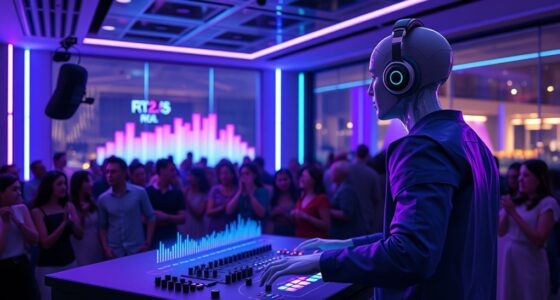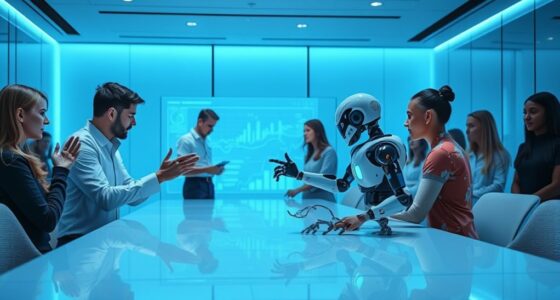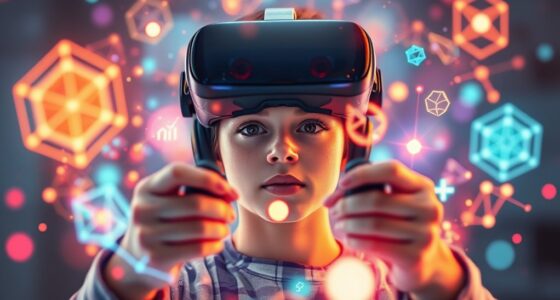Are you prepared to unleash the full potential of your artistic creations?
With generative AI, we can revolutionize the way we express ourselves through art.
Imagine the possibilities of AI-generated art, pushing the boundaries of visual storytelling and innovation.
Let’s bridge the gap between AI and human creativity, unleashing a new wave of artistic applications.

Join us as we explore the exciting world of enhancing creativity with generative AI.
The future of art starts here.
Key Takeaways
- Generative AI technologies can enhance artistic applications by unleashing creativity.
- AI can help expand artistic boundaries and challenge traditional art norms.
- AI can serve as a creative assistant, facilitating idea generation and streamlining workflow for artists.
- The use of AI in art raises ethical implications such as questions of authorship and the impact on traditional art markets.
The Role of Generative AI in Artistic Expression
Generative AI plays a pivotal role in enhancing artistic expression by enabling us to create unique and innovative artworks. This technology revolutionizes the creative process by providing us with new tools for collaborative creativity and AI-powered inspiration.
With generative AI, artists can harness the power of machine learning algorithms to explore uncharted territories and push the boundaries of traditional art forms. By leveraging vast amounts of data, generative AI algorithms can generate novel ideas, inspiring artists to experiment with new techniques, styles, and concepts.

This collaborative approach between artists and AI fosters a symbiotic relationship, where the machine becomes a partner in the creative process, empowering us to tap into new realms of imagination and produce groundbreaking works of art. The possibilities are limitless, and generative AI opens up a world of opportunities for artistic innovation.
Exploring the Potential of AI-Generated Art
As we delve deeper into the role of generative AI in enhancing artistic expression, it’s imperative to explore the vast potential of AI-generated art. One important consideration is the ethical implications surrounding AI-generated art and copyright. With AI’s ability to create original works, questions arise regarding ownership and intellectual property. Should AI-generated art be protected by copyright law? How does one attribute authorship in a collaborative process involving AI? These are complex issues that require careful examination to ensure fairness and protection for both artists and AI systems.
In addition to ethical concerns, it’s crucial to explore the emotional impact of AI-generated art and its ability to forge human connections. Can AI-generated art evoke the same emotional response as art created by humans? Can it resonate with audiences on a deep, personal level? Understanding the emotional potential of AI-generated art is essential to harnessing its power as a means of artistic expression and communication.
Enhancing Visual Storytelling With Generative AI
Exploring the capabilities of generative AI in enhancing visual storytelling is an exciting endeavor. This technology has the potential to revolutionize the way we tell stories through visuals, providing new tools and techniques for artists and creators.

Here are three ways generative AI is enhancing visual storytelling:
-
Generative AI in Fashion: By leveraging generative AI, fashion designers can create unique and innovative designs that push the boundaries of traditional fashion. AI algorithms can generate patterns, textures, and even entire garments, allowing designers to experiment and explore new creative possibilities.
-
Generative AI in Architecture: Generative AI is also being used in architecture to generate complex and intricate designs. By inputting specific parameters and constraints, architects can use AI algorithms to generate multiple design options, saving time and effort in the design process. This technology enables architects to explore different iterations and find the most suitable design solution.
-
Enhanced Immersion: Generative AI can enhance visual storytelling by creating immersive and interactive experiences. By dynamically generating visuals based on user inputs or real-time data, AI algorithms can create personalized and engaging narratives that captivate and involve the audience in the storytelling process.

Pushing Boundaries: AI as a Tool for Innovation in Art
To push the boundaries of artistic innovation, we can utilize AI as a powerful tool. AI-driven artistic collaborations have the potential to redefine traditional art forms and revolutionize the way we create and appreciate art. By harnessing the capabilities of AI, artists can explore new possibilities and break free from conventional artistic boundaries.
Through AI-driven artistic collaborations, artists can tap into the vast computational power and unique algorithms of AI systems to generate new and unconventional ideas. These collaborations enable artists to experiment with different styles, techniques, and mediums, pushing the boundaries of what’s considered traditional art.
AI-powered tools can assist artists in creating innovative and visually striking artworks, providing them with new avenues for expression. Whether it’s through generating novel visual compositions, suggesting alternative color palettes, or even generating entirely new art forms, AI can unlock a world of possibilities for artistic innovation.
Bridging the Gap: AI and Human Creativity in Art
We can bridge the gap between AI and human creativity in art by harnessing the collaborative potential of generative AI technologies. By combining AI and traditional art techniques, we can create innovative and unique artworks that blend the strengths of both human artists and AI algorithms. This collaboration allows for the exploration of new artistic possibilities and the pushing of boundaries in the art world.

Additionally, utilizing generative AI technologies enables artists to enhance their creative process, providing them with new tools and techniques to experiment with. However, it’s important to consider the ethical implications of AI-generated art. Questions regarding authorship, originality, and the role of human creativity in a world increasingly influenced by AI need to be addressed.
This bridge between AI and human creativity in art can lead to exciting advancements, but it requires careful consideration and ongoing dialogue.
- Combining AI and traditional art techniques
- Exploring new artistic possibilities
- Enhancing the creative process
Frequently Asked Questions
How Does Generative AI Technology Work in the Context of Artistic Expression?
Generative AI techniques harness machine learning algorithms to unlock creative potential in art generation. Through AI assisted creativity, artists can explore new avenues of artistic expression, collaborate with AI, and produce innovative digital art. AI generated artwork enhances artistic innovation.
Are There Any Ethical Concerns Associated With Using Ai-Generated Art?
There are ethical concerns associated with using AI-generated art. The implications include issues of authorship, plagiarism, and the potential devaluation of human creativity. These ethical debates are important for the future of artistic expression.

Can Generative AI Be Used to Enhance Traditional Art Techniques?
Generative AI applications have revolutionized traditional art techniques, propelling innovation to new heights. By combining the power of artificial intelligence with human creativity, artists can explore uncharted territories and unlock limitless possibilities in their artistic endeavors.
What Are Some Examples of Successful Collaborations Between Artists and AI Systems?
Exploring new artistic frontiers, we have witnessed the power of collaboration between artists and AI systems. Examples include the creation of music, visual art, and even poetry, where AI enhances traditional techniques for groundbreaking results.
How Does the Use of Generative AI Impact the Role of the Artist in the Creative Process?
Generative AI revolutionizes the artist’s role by enhancing their creative autonomy. It opens up collaborative possibilities, allowing artists and AI to work together in the creative process. This innovation empowers artists to explore new horizons and push the boundaries of artistic expression.
Conclusion
In conclusion, generative AI has emerged as a powerful tool in enhancing artistic applications, unleashing a wave of creativity like never before.

It has the potential to transform the way we perceive and create art, pushing the boundaries of visual storytelling and innovation.
By bridging the gap between AI and human creativity, we’re able to unlock new realms of imagination, where the possibilities are endless and the artistry knows no bounds.
The future of art is truly limitless with the advent of generative AI.











